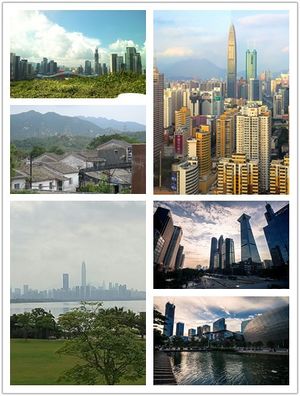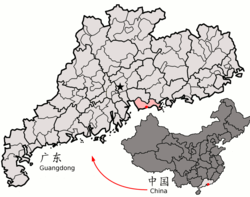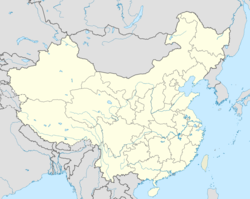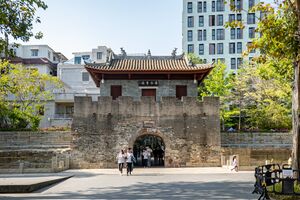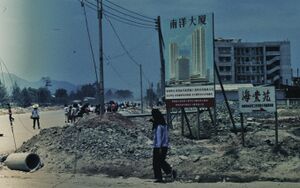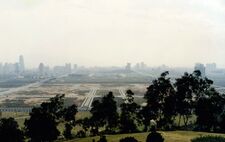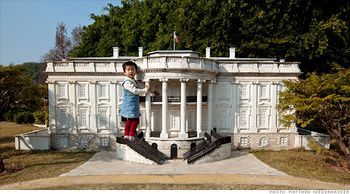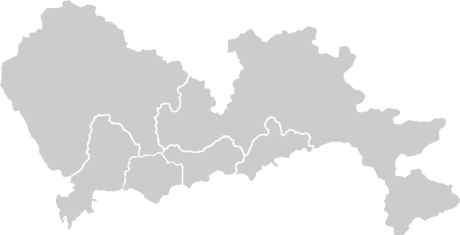شنجن (الصين)
| ||||||||||||||||||||||||||||||||||||||||||||||||||||||||||||||||
| ||||||||||||||||||||||||||||||||||||||||||||||||||||||||||||||||
شنژن أو شنجن (بالصينية: 深圳 = Shēnzhèn) هي مدينة كبرى في مقاطعة گوانگدونگ بجنوب الصين، بالقرب مباشرة شمال هونگ كونگ. وقد أصبحت المنطقة أول وأحد أنجح المناطق الاقتصادية الخاصة في الصين. وتحظى ادارياً بوضع مدينة تحت المقاطعة، بسلطات أقل قليلاً من مقاطعة.[2]
كانت شنژن بلدة سوق بتعداد 30,000 نسمة على جانب سكة حديد كاولون-كانتون. وقد تغير ذلك في 1979 حين تقرر ترقية شنژن إلى وضع مدينة وفي 1980 أُعلِنت أول منطقة اقتصادية خاصة (SEZ) في الصين.[3] وحسب تقرير الحكومة في 2015، فإن شنژن تحولت إلى مدينة بتعداد 10,778,900[4] ويزيد تعداد المنطقة العمرانية عن 18 مليون. وكانت شنژن أسرع مدن العالم نمواً في عقدي 1990 و 2000.[5] ارتفاع تعداد السكان تباطأ إلى أقل من واحد في المائة في عام 2013 مع انتهاء فورة التصنيع ليحل محلها قطاعات اقتصادية أخرى.[6]
خط الأفق المعاصر لشنژن هو نتيجة الاقتصاد النابض بالنشاط والذي لم يكن ممكنا بدون استثمارات أجنبية منذ اعلان سياسة "الاصلاح والانفتاح" التي أسست المناطق الاقتصادية الخاصة في أواخر 1979، وقبل ذلك كانت شنژن مجرد قرية صغيرة. وقد استثمر الصينيون والأجانب أموالاً طائلة فيها، تُقدر بنحو 30 بليون دولار، ذهب معظمها في البداية إلى التصنيع ومؤخراً امتدت إلى صناعة الخدمات كذلك. وتُعتبر شنژن حالياً أحد أسرع المدن نمواً في العالم.[7]
ولكونها المركز المالي لجنوب الصين، فإن شنژن هي مقر بورصة شنژن للأوراق المالية، كما أنها مقر العديد من شركات التكنولوجيا المتقدمة.[8] وتحظى شنژن بالترتيب التاسع عشر في نسخة عام 2016 من مؤشر المراكز المالية العالمية الذي تنشره Z/Yen Group و مركز قطر المالي.[9] كما أن شنژن هي أحد أزحم موانئ الحاويات في الصين.[10]
. . . . . . . . . . . . . . . . . . . . . . . . . . . . . . . . . . . . . . . . . . . . . . . . . . . . . . . . . . . . . . . . . . . . . . . . . . . . . . . . . . . . . . . . . . . . . . . . . . . . . . . . . . . . . . . . . . . . . . . . . . . . . . . . . . . . . . . . . . . . . . . . . . . . . . . . . . . . . . . . . . . . . . . .
أصل الاسم
The earliest known recorded mention of the name chen could date from 1410, during the Ming Dynasty.[11] Locals call the drains in paddy fields "Zhen" (صينية: 圳؛ حرفياً: 'ditch, drain'�). Shenzhen was named after a deep (صينية: 深؛ حرفياً: 'deep'�) drain that was located within the area."[12][13]
التاريخ
قبل التاريخ إلى عهد مينگ
The oldest evidence of humans in the area on which Shenzhen was established dates back during the mid-Neolithic period.[14][15] Since then, this area has seen human activity from more than 6,700 years ago, with Shenzhen's historic counties first established 1,700 years ago, and the historic towns of Nantou and Dapeng, which was built on the area that is now Shenzhen, established more than 600 years ago.[16] The Hakka people also have a history in Shenzhen since 300 years ago when they first immigrated.
In 214 BC, when Emperor Qin Shi Huang unified China under the Qin Dynasty, the area went under the jurisdiction of the established Nanhai Commandery, one of the three commanderies that were set up in Lingnan, and was assimilated into Zhongyuan culture.[17] In 331 AD, the Eastern Jin administration split up Nanhai and established a new Dongguan Commandery (东官郡).[18] The seat of both the commandery and Bao'an County, one of its six counties, was located around the modern town of Nantou. In 590, the Sui administration merged the region back into Nanhai. In 757, the Tang administration renamed the county Dongguan, and moved its seat to what is now Dongguan city, although a military garrison remained.[17]
During the Song Dynasty, Nantou and the surrounding area became an important trade hub for salt and spices in the South China Sea.[17][19] The area then became known for producing pearls during the Yuan Dynasty. In the early Ming era, Chinese sailors of a fleet would go to a Mazu temple in Chiwan (in present-day Nanshan District) to pray as they go to Nanyang (Southeast Asia). The Battle of Tunmen, when the Ming won a naval battle against invading Portuguese, was fought south of Nantou.[20] In 1573, the Ming administration established Xin'an County, based in Nantou, which had authority over regions that would be Shenzhen and Hong Kong. Xin'an County's economy primarily was based on the production and trade of salt, tea, spices, and rice.
عهد تشينگ إلى ع1940
To prevent a rebellion from Ming loyalists under Zheng Chenggong, better known as Koxinga, on the Chinese coast, the recently established Qing administration resettled coastal residents inland and re-organized coastal counties.[17] As a result, Xin'an County lost two-thirds of its territory to the neighboring Dongguan County and was later incorporated into Dongguan in 1669, though Xin'an was restored about 15 years later, in 1684. After the Qing dynasty was defeated by the United Kingdom in the First and Second Opium Wars, Hong Kong Island and the Kowloon Peninsula were separated from Xin'an and ceded to the British in the Treaty of Nanking and the Convention of Peking. On 21 April 1898, the Qing government signed a "Special Article for the Exhibition of Hong Kong's Borders" with the United Kingdom, and leased the New Territories from Xin'an to the United Kingdom for 99 years. Xin'an was briefly occupied by a British force under the command of Henry Arthur Blake, the governor of Hong Kong, for half a year in 1899.[21] From the 3,076 square kilometres (1,188 sq mi) of territory that Xin'an held before the treaties, 1,055.61 square kilometres (407.57 sq mi) of the county was ceded to the British.[18]
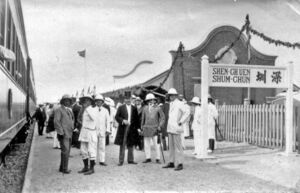
In response to the Wuchang Uprising in 1911, Xin'an residents rebelled against the local Qing administration and successfully overthrew them.[22] In the same year the Chinese section of the Kowloon–Canton Railway (KCR) was opened to the public, and the last stop of the Chinese side, Shenzhen Railway Station, had opened in Shenzhen, helping the town's economy and opened Shenzhen up to the world.[21][23] In 1913, the Republic of China administration renamed Xin'an County back to Bao'an County to prevent confusion from another county of the same name in Henan Province.[17] During the Canton–Hong Kong strike, the All-China Federation of Trade Unions set up a reception station for strike workers in Hong Kong in Shenzhen.[24] Strike workers were also given pickets and armored vehicles by the strike committee to create a blockade around Hong Kong. In 1931, Chen Jitang and his family established several casinos in Shenzhen, the largest of which being Shumchun Casino.[25] While only in operation until 1936, they significantly increased KCR's passenger traffic to and from Shenzhen.
During World War II, the Japanese occupied Shenzhen and Nantou,[17] forcing the Bao'an County government to relocate to the neighboring Dongguan County.[26][27] In 1941, the Japanese army tried to cross into Hong Kong through the Lo Wu Bridge in Shenzhen, though this was detonated by the British, preventing the Japanese from entering Hong Kong.[28] When Japan surrendered in September 1945, the Bao'an County government moved back to Nantou.
ع1950 إلى 1975
In 1953, four years after the founding of the People's Republic of China, the Bao'an County government decided to move to Shenzhen, since the town was closer to the KCR and had a larger economy than Nantou.[17] From the 1950s to the end of the 1970s, Shenzhen and the rest of Bao'an County oversaw a huge influx of refugees trying to escape to Hong Kong from the upheavals that were occurring in mainland China, and a range from 100,000[29] to 560,000[30] refugees resided in the county.
In January 1978, a Central Inspection Team sent by the State Council investigated and established the issue of creating a foreign trade port in Bao'an County.[31] In May, the investigation team wrote the "Hong Kong and Macao Economic Investigation Report" and proposed to turn Bao'an County and Zhuhai into commodity export bases. In August 1978, the Huiyang District Committee reported to the Provincial Committee on the "Report on the Request for the Change of Bao'an County to Shenzhen". On 18 October, the Standing Committee of the Guangdong Provincial Party Committee decided to change Bao'an County into Bao'an City and to turn it into a medium-level prefecture-level city with a foreign trade base. The Huiyang District Committee and the Bao'an County Committee, however, defended the change to rename Bao'an County to Shenzhen, claiming that people in the world know more about Shenzhen and its port than they know about Bao'an County.
On 23 January 1979, the Guangdong provincial administration and the district of Huiyang announced their proposal to rename Bao'an County to Shenzhen and was approved and put into effect by the State Council on March 5 of that year.[31] Also, the city would establish six districts: Luohu, Nantou, Songgang, Longhua, Longgang and Kuiyong. On 31 January 1979, the Central Committee of the Communist Party approved a plan to establish the Shekou Industrial Zone in Shenzhen with the purpose "to lead domestic, overseas, and diversified operations, industrial and commercial integration, and trading" based on the systems of that of Hong Kong and Macau.[32] The Shekou Industrial Zone project was led by Hong Kong-based China Merchants Group under Yuan Geng's leadership and was to become the first export processing industrial zone in mainland China.
At the beginning of April 1979, the Standing Committee of Guangdong Province discussed and proposed to the Central Committee to set up a "trade cooperation zone" in Shenzhen, Zhuhai, and Shantou.[31] In the same month, the Central Working Conference decided on the "Regulations on Vigorously Developing Foreign Trade to Increase Foreign Exchange Income" and agreed to pilot the first special economic zones (SEZ) in Shenzhen, Zhuhai, Shantou, and Xiamen.[33] In November, Shenzhen was elevated to the status of prefecture-level city at the regional level by the Guangdong provincial administration.[22]
المنطقة الاقتصادية الخاصة (ع1980–الحاضر)
In May 1980, the Central Committee designated Shenzhen as the first SEZ in China,[17][34] which was promoted by then-paramount leader Deng Xiaoping as part of China's "reform and opening-up" reforms which were set up a year previously.[35] Its objective is to be an experimental ground for the practice of market capitalism within a community guided by the ideals of "socialism with Chinese characteristics".[36][37][38] On 26 August, the Standing Committee of the National People's Congress (NPC) approved the "Regulations of the Guangdong Special Economic Zone."[39] Under these regulations, Shenzhen formulated a series of preferential policies to attract foreign investment, including business autonomy, taxation, land use, foreign exchange management, product sales, and entry and exit management. Through the processing of incoming materials, compensation trade, joint ventures, cooperative operations, sole proprietorship, and leasing, the city has attracted a large amount of foreign investment and helped popularize and enable rapid development of the SEZ concept.
In March 1981, Shenzhen was promoted to a sub-provincial city.[14][17] There were plans for Shenzhen to develop its currency, but the plans were shelved due to the risk and the disagreement that a country should not be operating with two currencies.[40] To enforce law and order in the city, the Shenzhen government erected barbed wire and checkpoints between the land borders of the main sections of the SEZ and the SEZ outskirts, as well as the rest of China, in 1983, which was known as the second line border (صينية: 二线关�).[41][42] In November 1988, Shenzhen became a city under separate state planning (计划单列市�), meaning that the city can implement policies that are different from those in the national plan, and was given the right of provincial-level economic administration.

In December 1990, under the authority of the China Securities Regulatory Commission, the Shenzhen Stock Exchange was established to provide a platform for centralized securities trading.[43] In February 1992, the Standing Committee of the NPC granted the government of Shenzhen the power to make local laws and regulations.[13] In 1996 and early 1997, the Shenzhen Guesthouse Hotel in Shenzhen was home to the Provisional Legislative Council and Provisional Executive Council of Hong Kong in preparation for the handover of Hong Kong in 1997.[44][45] By 2001, as a result of Shenzhen's increasing economic prospects, increasing numbers of migrants from mainland China chose to go to Shenzhen and stay there instead of trying to illegally cross into Hong Kong.[46] There were 9,000 captured border-crossers in 2000, while the same figure was 16,000 in 1991. Around the same time, Shenzhen hosted the second Senior Officials' Meeting of APEC China 2001 on 26 May 2001 in its southern manufacturing center and port.[47] In May 2008, the State Council approved the Shenzhen SEZ to promote Shenzhen's administrative management system, economic system, social field, independent innovation system and mechanism, system and mechanism for opening up and regional cooperation, and resource conservation and environmental friendliness.[48]
On 1 July 2010, the State Council dissolved the "second line," and expanded the Shenzhen SEZ to include all districts, a five-fold increase over its pre-expansion size.[49] On 26 August 2010, on the 30th anniversary of the establishment of the Shenzhen SEZ, the State Council approved the "Overall Development Plan for Qianhai Shenzhen-Hong Kong Modern Service Industry Cooperation Zone."[50] In August 2011, the city hosted the 26th Universiade, an international multi-sport event organized for university athletes.[51] In April 2015, the Shekou Industrial Zone and the Qianhai Zone were integrated within the newly established Guangdong Free-Trade Zone.[52]
On 18 August 2019, the central government in Beijing unveiled reform plans covering economical, social, and political sectors of Shenzhen, intending to have the SEZ be a model city for cities in China and the world to follow.[53]
. . . . . . . . . . . . . . . . . . . . . . . . . . . . . . . . . . . . . . . . . . . . . . . . . . . . . . . . . . . . . . . . . . . . . . . . . . . . . . . . . . . . . . . . . . . . . . . . . . . . . . . . . . . . . . . . . . . . . . . . . . . . . . . . . . . . . . . . . . . . . . . . . . . . . . . . . . . . . . . . . . . . . . . .
الجغرافيا
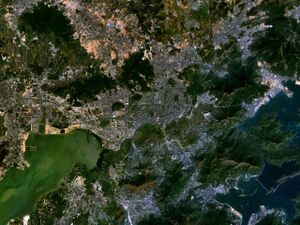
Shenzhen is located within the Pearl River Delta, bordering Hong Kong to the south, Huizhou to the north and northeast, Dongguan to the north and northwest. Lingdingyang and Pearl River to the west and Mirs Bay to the east and roughly 100 kilometres (62 mi) southeast of the provincial capital of Guangzhou. As of the end of 2017, the resident population of Shenzhen was 12,528,300, of which the registered population was 4,472,200, the actual administrative population was over 20 million.[54] It makes up part of the Pearl River Delta built-up area with 44,738,513 inhabitants, spread over 9 municipalities (including Macau). The city is elongated measuring 81.4 kilometers from east to west while the shortest section from north to south is 10.8 kilometers.
Over 160 rivers or channels flow through Shenzhen. There are 24 reservoirs within the city limits with a total capacity of 525 million tonnes.[55] Notable rivers in Shenzhen include the Shenzhen River, Maozhou River and Longgang River.[56]
Shenzhen is surrounded by many islands. Most of them fall under the territory of neighbouring areas such as Hong Kong Special Administrative Region and Huiyang District, Huizhou. But there are several islands under Shenzhen's jurisdiction, such as Nei Lingding Island, Dachan Island (Tai Shan Island), Xiaochan Island, Mazhou, Laishizhou, Zhouzai and Zhouzaitou. (See List of islands in Shenzhen)
المناخ
Although Shenzhen is situated about a degree south of the Tropic of Cancer, due to the Siberian anticyclone it has a warm, monsoon-influenced, humid subtropical climate (Köppen Cwa) though it is fairly close to a Tropical one. Winters are mild and relatively dry, due in part to the influence of the South China Sea, and frost is very rare; it begins dry but becomes progressively more humid and overcast. However, fog is most frequent in winter and spring, with 106 days per year reporting some fog. Early spring is the cloudiest time of year, and rainfall begins to dramatically increase in April; the rainy season lasts until late September to early October. With monthly percent possible sunshine ranging from 27 percent in March to 53 percent in October, the city receives 1,853 hours of bright sunshine annually.
| شنژن | ||||||||||||||||||||||||||||||||||||||||||||||||||||||||||||
|---|---|---|---|---|---|---|---|---|---|---|---|---|---|---|---|---|---|---|---|---|---|---|---|---|---|---|---|---|---|---|---|---|---|---|---|---|---|---|---|---|---|---|---|---|---|---|---|---|---|---|---|---|---|---|---|---|---|---|---|---|
| جدول طقس (التفسير) | ||||||||||||||||||||||||||||||||||||||||||||||||||||||||||||
| ||||||||||||||||||||||||||||||||||||||||||||||||||||||||||||
| ||||||||||||||||||||||||||||||||||||||||||||||||||||||||||||
. . . . . . . . . . . . . . . . . . . . . . . . . . . . . . . . . . . . . . . . . . . . . . . . . . . . . . . . . . . . . . . . . . . . . . . . . . . . . . . . . . . . . . . . . . . . . . . . . . . . . . . . . . . . . . . . . . . . . . . . . . . . . . . . . . . . . . . . . . . . . . . . . . . . . . . . . . . . . . . . . . . . . . . .
تطورها
قبل 1980 كانت المدينة تسمي "باو آن"، لم يتجاور عدد سكانها الـ20 ألفا وكان نشاطها مقتصرا على الصيد. تحولت المدينة بعدها وشكلت امتدادا لجزيرة "هونگ كونگ". منذ أن أصبحت منطقة إقتصادية خاصية أخذت في التوسع كل يوم. تحظى بموقع استراتيجي، في الوسط الجغرافي بين "هونگ كونگ" و"گوانگژو" (عاصمة المقاطعة)، المكان الأمثل لإنشاء صناعات حديثة. تزدهر فيها الصناعات الخفيفة كإنتاج التحف الفنية والصناعات التقليدية، المنسوجات، الأدوية ومواد لبناء. كما تمد "شينتشين" "هونگ كونگ" بحاجياتها من مياه الشرب والمواد الغذائية.
أفق المدينة
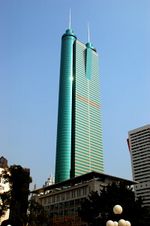
المنطقة الاقتصادية
تقع على الحدود مع "هونگ كونگ"، يمر عبرها خط السكة الحديدية الواصل بين "گوانگژو" و"هونگ كونگ". أصبحت المدينة وضواحيها عام 1981 أول منطقة إقتصادية خاصة في جمهورية الصين الشعبية. قامت الحكومة الصينية بإنشاء هذه المناطق لفتح إقتصاد البلاد على الإستثمارات الخارجية. تقترح هذ المناطق على المستثمرين مزايا ضريبية هامة، والضرائب فيها أقل من تلك المعمول فيها في باقي أرجاء الصين، كما تتوافد إليها اليد العاملة الرخيصة.
الأقسام الإدارية
شن ژن هي مدينة تحت المقاطعة. ولها سلطة إدارية مباشرة على ست مديريات.
| الاسم | الحروف الصينية (هانزي) | هانيو پنين | ||
|---|---|---|---|---|
| المديريات | ||||
| لووهو | 罗湖区 | Luóhú Qū | ||
| فوتيان | 福田区 | Fútián Qū | ||
| نانشان | 南山区 | Nánshān Qū | ||
| يانتيان | 盐田区 | Yántián Qū | ||
| باوآن | 宝安区 | Bǎo'ān Qū | ||
| لونگگانگ | 龙岗区 | لونگگانگ تشو | ||
الطقس
| متوسطات الطقس لشنژن | |||||||||||||
|---|---|---|---|---|---|---|---|---|---|---|---|---|---|
| شهر | يناير | فبراير | مارس | أبريل | مايو | يونيو | يوليو | أغسطس | سبتمبر | اكتوبر | نوفمبر | ديسمبر | |
| متوسط العظمى °م (°ف) | 20 (68) | 20 (68) | 22 (72) | 26 (79) | 29 (84) | 31 (88) | 32 (90) | 32 (90) | 31 (88) | 29 (84) | 25 (77) | 21 (70) | |
| متوسط الصغرى °م (°ف) | 13 (55) | 13 (55) | 16 (61) | 20 (68) | 24 (75) | 26 (79) | 26 (79) | 26 (79) | 25 (77) | 22 (72) | 18 (64) | 14 (57) | |
| هطول الأمطار mm (بوصة) | 21 (0.8) | 33 (1.3) | 45 (1.8) | 113 (4.4) | 159 (6.3) | 238 (9.4) | 252 (9.9) | 282 (11.1) | 166 (6.5) | 41 (1.6) | 22 (0.9) | 21 (0.8) | |
| المصدر: per MSN 2008 | |||||||||||||
مدن شقيقة
تشريعات قانونية
بدأ الصينيون يدركون مخاطر تناول أي حيوان يرونه، ففي قرار تاريخي أقرت مدينة شنژن الصينية فرض حظراً على اكل الكلاب و القطط بدءاً من 1 مايو عام 2020 المقبل . قانونا يمنع تناول لحوم الكلاب والقطط، وسط محاولات علمية حثيثة للتوصل إلى المصدر الذي نقل فيروس كورونا من الحيوانات البرية إلى البشر.[64]
المصادر
- ^ "Shenzhen's GDP per capita reached 149.5 thousand Yuan in 2014 which ranked the first among all sub-provincial cities" (in Chinese). China Economics.
{{cite web}}: CS1 maint: unrecognized language (link) - ^ "中央机构编制委员会印发《关于副省级市若干问题的意见》的通知. 中编发[1995]5号". 豆丁网. 1995-02-19. Archived from the original on 29 May 2014. Retrieved 2014-05-28.
{{cite web}}: Unknown parameter|deadurl=ignored (|url-status=suggested) (help) - ^ Fish, Isaac Stone (2010-09-25). "A New Shenzhen". Newsweek. Retrieved 2014-04-29.
- ^ "2000-2014年各市年末常住人口数_2015年广东统计年鉴查阅和Excel下载_数析网(tjsql.com)". www.tjsql.com. Retrieved 2016-05-01.
- ^ "Shenzhen". U.S. Commercial Service. 2007. Archived from the original on 12 December 2011. Retrieved 28 February 2008.
{{cite web}}: Unknown parameter|deadurl=ignored (|url-status=suggested) (help) - ^ "深圳人口数量2015". Retrieved 25 May 2015.
- ^ "Shenzhen". U.S. Commercial Service. 2007. Retrieved 2008-02-28.
- ^ "Inside Shenzhen: China's Silicon Valley". The Guardian. Retrieved 25 May 2015.
- ^ "The Global Financial Centres Index 19". Long Finance. March 2016.
- ^ "The JOC Top 50 World Container Ports". Retrieved 25 May 2015.
- ^ 深圳地名网 (27 May 2010). 深圳地名. Shenzhen People's Government. Archived from the original on 4 October 2011. Retrieved 14 November 2011.
- ^ 深圳概貌. Shenzhen People's Government. 12 July 2011. Archived from the original on 4 November 2011. Retrieved 25 October 2011.
- ^ أ ب 央视国际 (2003-08-07). 深圳历史沿革. CCTV. Archived from the original on 2013-06-02. Retrieved 2011-10-25.
- ^ أ ب 深圳概貌. Shenzhen People's Government. 12 July 2011. Archived from the original on 4 November 2011. Retrieved 25 October 2011.
- ^ 深圳的前身并不是"小渔村". Archived from the original on 17 October 2018. Retrieved 17 October 2018.
- ^ 深圳概貌. Shenzhen People's Government. 2016-08-26. Archived from the original on 2017-03-02. Retrieved 2016-10-25.
- ^ أ ب ت ث ج ح خ د ذ 深圳历史沿革. China Central Television. 7 August 2003. Archived from the original on 2 June 2013. Retrieved 25 October 2011.
- ^ أ ب Brief History of Shenzhen Archived أبريل 16, 2008 at the Wayback Machine, Shenzhen Government official website.
- ^ Rule, Ted and Karen, "Shenzhen, the Book", Hong Kong 2014
- ^ Wills, John E. (2011), China and Maritime Europe, 1500–1800: Trade, Settlement, Diplomacy, and Missions, Cambridge University Press, p. 28
- ^ أ ب 深圳旧事 | 英国两千军队占领深圳长达半年,这是怎么回事?. sohu.com (in الإنجليزية). Retrieved 2019-08-05.
- ^ أ ب 龙华革命烈士卓凤康. 宝安日报. 2012-02-18. Archived from the original on 2017-08-31. Retrieved 2014-11-07.
- ^ "百年深圳铁路". news.ifeng.com. Archived from the original on 31 August 2017. Retrieved 2019-08-05.
- ^ 深圳地区的革命史迹_查查吧. chachaba.com. Retrieved 2019-08-05.
- ^ "The Kowloon Canton Railway (British Section) Part 4 – The Early Years (1910 to 1940) – The Industrial History of Hong Kong Group". industrialhistoryhk.org. Retrieved 2019-08-05.
- ^ 秦志勇 (2003-06-24). 台盟深圳市委筹委会呼吁缅怀三洲田起义丰功. 中国政协新闻. Archived from the original on 2014-02-03. Retrieved 2011-10-22.
- ^ 惠州三洲田起义. 今日惠州. 2011-05-31. Archived from the original on 2012-05-25. Retrieved 2011-10-22.
- ^ 李南玲 (2003-08-21). 百年罗湖桥走进历史. Xinhua. Archived from the original on 2004-06-27. Retrieved 2011-10-22.
- ^ 中国青年报 (2010-12-08). "学者记录深圳30年大逃港 百万内地人曾越境香港". 新浪新闻. Archived from the original on 2010-12-11. Retrieved 2011-10-22.
- ^ 武汉晨报 (2010-12-08). ""大逃港"催生深圳经济特区". 网易新闻. Archived from the original on 2017-09-07. Retrieved 2011-10-22.
- ^ أ ب ت 深圳特区建立过程中惠阳地区的历史作用. 中共惠州市委党史研究室课题组. 2015-12-07. Archived from the original on 2017-04-18.
- ^ 1月31日,中央决定成立招商局蛇口工业区. 深圳特区报. 2010-01-31. Archived from the original on 7 September 2017. Retrieved 5 August 2019.
- ^ 1979年4月邓小平第一次正式提出办特区的主张. Beijing Daily. 2008-09-16. Archived from the original on 25 August 2017. Retrieved 5 August 2019.
- ^ Fish, Isaac Stone (25 September 2010). "A New Shenzhen". Newsweek. Archived from the original on 29 April 2014. Retrieved 29 April 2014.
Shenzhen grew over the past three decades by capitalizing on both its advantageous coastal location and proximity to Hong Kong and Taiwan (major sources of investment capital), but also on the huge Chinese government support that came with its designation as the first Special Economic Zone.
- ^ "Shenzhen Continues to lead China's reform and opening-up". Archived from the original on 9 July 2018. Retrieved 9 September 2016.
Shenzhen, [...] which was just a small town when it was chosen as China's first special economic zone to pilot the country's reform and opening-up drive 22 years ago, has now grown into a boomtown, which is placed fourth among Chinese cities in overall economic strength.
- ^ Stoltenberg, Clyde D. (1984). "China's Special Economic Zones: Their Development and Prospects". Asian Survey. 24 (6): 637–654. doi:10.2307/2644396. ISSN 0004-4687. JSTOR 2644396.
- ^ Holmes, Frank (21 Apr 2017). "China's New Special Economic Zone Evokes Memories Of Shenzhen". Forbes (in الإنجليزية). Archived from the original on 22 March 2019. Retrieved 22 March 2019.
- ^ "The spirit of enterprise fades: Capitalism in China". The Economist. Vol. 394, no. 8666. 23 January 2010. p. 61. Archived from the original on 28 January 2010. Retrieved 28 January 2010.
- ^ 深圳经济特区. 广东省情网. 2011-05-05. Archived from the original on 7 September 2017. Retrieved 5 August 2019.
- ^ "2006年1月". mjlsh.usc.cuhk.edu.hk. Retrieved 2019-08-05.
- ^ 二线关 将说真正的再见. Southern Metropolis Daily. 2014-12-23. Archived from the original on 2017-09-07. Retrieved 2015-10-21.
- ^ 交通动态 (2010-06-08). 深圳二线关是怎么来的. 深圳本地宝. Archived from the original on 2011-08-22. Retrieved 2011-10-22.
- ^ 关于本所. Shenzhen Stock Exchange. Archived from the original on 2011-10-26. Retrieved 2011-10-22.
- ^ Singh, Harminder (2 September 2016). "Explained:how Hong Kong's Legislative Council has evolved". South China Morning Post. Archived from the original on 29 March 2019. Retrieved 29 March 2019.
- ^ "Legislative Council of the Hong Kong Special Administrative Region – History of the Legislature". Archived from the original on 9 December 2015. Retrieved 25 May 2015.
- ^ Perry, Alex (2001-05-07). "Crossing The Line". Time Asia. Vol. 157, no. 18. Archived from the original on 3 June 2001. Retrieved 2018-11-15.
- ^ "2001APEC". china.org.cn. Retrieved 2020-06-04.
- ^ 《深圳市综合配套改革总体方案》获国务院批准. 新华网. 2009-05-26. Archived from the original on 2017-08-25. Retrieved 2017-02-01.
- ^ 郑小红 (2010-07-02). 深圳特区范围1日起扩至全市 解决"一市两法". 中国新闻网. Archived from the original on 2014-02-04. Retrieved 2011-10-22.
- ^ 国务院批复"前海深港现代服务业合作区发展规划". 新华社. 2010-08-27. Archived from the original on 2017-08-25. Retrieved 2017-02-01.
- ^ "Universiade Shenzhen 2011". Archived from the original on 17 March 2016. Retrieved 19 June 2016.
- ^ 总体概况. 广东自贸试验区前海蛇口片区. 2016-04-06. Archived from the original on 2016-10-27. Retrieved 2016-10-22.
- ^ "China unveils detailed reform plan to make Shenzhen model city for world". South China Morning Post (in الإنجليزية). 2019-08-18. Retrieved 2019-08-19.
- ^ 深圳概貌 [Shenzhen overview]. Archived from the original on 30 September 2018. Retrieved 25 Sep 2018.
- ^ 市情概貌. Archived from the original on 20 September 2016. Retrieved 9 September 2016.
- ^ 深圳310条河流 173条黑脏臭 径流小是先天的硬伤. Archived from the original on 27 February 2017. Retrieved 9 September 2016.
- ^ 友好城市 (Friendly cities), 市外办 (Foreign Affairs Office), 2008-03-22. (Translation by Google Translate.)
- ^ 国际友好城市一览表 (International Friendship Cities List), 2011-01-20. (Translation by Google Translate.)
- ^ 友好交流 (Friendly exchanges), 2011-09-13. (Translation by Google Translate.)
- ^ "Facts & Statistics". Our Brisbane. Archived from the original on 14 October 2007. Retrieved 2 January 2008.
- ^ "Poznań - Miasta partnerskie". 1998–2013 Urząd Miasta Poznania (in Polish). City of Poznań. Archived from the original on 2013-09-23. Retrieved 2013-12-11.
{{cite web}}: CS1 maint: unrecognized language (link) - ^ "Poznań Official Website - Twin Towns".
 (in Polish) © 1998–2008 Urząd Miasta Poznania. Retrieved 2008-11-29.
(in Polish) © 1998–2008 Urząd Miasta Poznania. Retrieved 2008-11-29.
- ^ Pessotto, Lorenzo. "International Affairs - Twinnings and Agreements". International Affairs Service in cooperation with Servizio Telematico Pubblico. City of Torino. Archived from the original on 2013-06-18. Retrieved 2013-08-06.
- ^ "Shenzhen becomes first Chinese city to ban consumption of cats and dogs".
انظر أيضا
- اقتصاد الصين
- المناطق الاقتصادية الخاصة في جمهورية الصين الشعبية
- التقسيمات الادارية للصين
- Sham Chun River (يعرف أيضا بنهر شنژن)
- Shenzhen Shangqingyin
- منطقة اقتصادية خاصة
وصلات خارجية
| Shenzhen
]].- Shenzhen Government Online
- Shenzhen Daily Daily English printed newspaper
- Shenzhen Wikitravel
- Bilingual Shenzhen map
- CS1 errors: unsupported parameter
- CS1 uses الصينية-language script (zh)
- Short description is different from Wikidata
- Articles containing صينية-language text
- Pages using infobox settlement with unknown parameters
- مقالات تحتوي نصوصاً باللغة الصينية
- Articles with hatnote templates targeting a nonexistent page
- مقالات تحتوي نصوصاً باللغة الصينية المبسطة
- Pages using image label with a wide image
- Pages using image label with a tall image
- شنژن
- مدن صينية
- مدن گوانگدونگ

